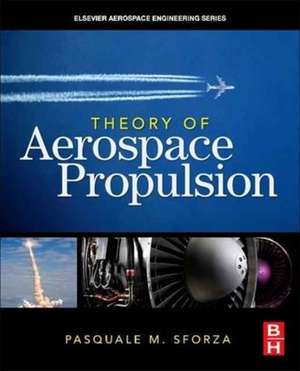Theory of Aerospace Propulsion: Aerospace Engineering
Autor Pasquale M Sforzaen Limba Engleză Paperback – 29 oct 2018
Readers of this book will be able to utilize the fundamental principles of fluid mechanics and thermodynamics to analyze aircraft engines; understand the common gas turbine aircraft propulsion systems and be able to determine the applicability of each; perform system studies of aircraft engine systems for specified flight conditions; perform preliminary aerothermal design of turbomachinery components; conceive, analyze, and optimize competing preliminary designs for conventional and unconventional missions. The book is organized into 15 chapters covering a wide array of topics such as idealized flow machines; quasi-one-dimensional flow equations; idealized cycle analysis of jet engines; combustion chambers for airbreathing engines; nozzles and inlets; turbomachinery; blade element analysis of axial flow turbomachines; turbine engine performance and component integration; propellers; liquid rockets; solid propellant rockets; nuclear rockets; space propulsion; and propulsion aspects of high-speed flight.
This book will appeal to aerospace or mechanical engineers working in gas turbines, turbomachinery, aircraft propulsion and rocket propulsion, and to undergraduate and graduate level students in aerospace or mechanical engineering studying aerospace propulsion or turbomachinery.
- Early coverage of cycle analysis provides a systems perspective, and offers context for the chapters on turbomachinery and components
- Broader coverage than found in most other books - including coverage of propellers, nuclear rockets, and space propulsion - allows analysis and design of more types of propulsion systems
- In depth, quantitative treatments of the components of jet propulsion engines provides the tools for evaluation and component matching for optimal system performance
- Worked examples and end of chapter exercises provide practice for analysis, preliminary design, and systems integration
Preț: 346.54 lei
Nou
Puncte Express: 520
Preț estimativ în valută:
66.32€ • 72.01$ • 55.71£
66.32€ • 72.01$ • 55.71£
Carte nepublicată încă
Doresc să fiu notificat când acest titlu va fi disponibil:
Se trimite...
Preluare comenzi: 021 569.72.76
Specificații
ISBN-13: 9780128102848
ISBN-10: 0128102845
Pagini: 704
Ilustrații: Approx. 250 illustrations
Dimensiuni: 195 x 252 mm
Editura: ELSEVIER SCIENCE
Seria Aerospace Engineering
ISBN-10: 0128102845
Pagini: 704
Ilustrații: Approx. 250 illustrations
Dimensiuni: 195 x 252 mm
Editura: ELSEVIER SCIENCE
Seria Aerospace Engineering
Public țintă
Aerospace or mechanical engineers working in gas turbines, turbomachinery, aircraft propulsion and rocket propulsion. Undergraduate and graduate level students in aerospace or mechanical engineering studying aerospace propulsion or turbomachinery.Cuprins
Chapter 1 IDEALIZED FLOW MACHINES
Chapter 2 QUASI-ONE-DIMENSIONAL FLOW EQUATIONS
Chapter 3 IDEALIZED CYCLE ANALYSIS OF JET ENGINES
Chapter 4 COMBUSTION CHAMBERS FOR AIRBREATHING ENGINES
Chapter 5 NOZZLES
Chapter 6 INLETS
Chapter 7 TURBOMACHINERY
Chapter 8 BLADE ELEMENT ANALYSIS OF AXIAL FLOW TURBOMACHINES
Chapter 9. TURBINE ENGINE PERFORMANCE AND COMPONENT INTEGRATION
Chapter 10 PROPELLERS
Chapter 11 LIQUID ROCKETS
Chapter 12 SOLID PROPELLANT ROCKETS
Chapter 13 NUCLEAR ROCKETS
Chapter 14 SPACE PROPULSION
Chapter 15. PROPULSION ASPECTS OF HIGH-SPEED FLIGHT
Appendix A: SHOCK WAVES, EXPANSIONS, TABLES AND CHARTS
Appendix B: PROPERTIES OF HYDROCARBON FUEL COMBUSTION
Appendix C: EARTH’S ATMOSPHERE
Appendix D: BOOST PHASE AND STAGING OF ROCKETS
Appendix E: SAFETY, RELIABILITY, AND RISK ASSESSMENT
Appendix F: AIRCRAFT PERFORMANCE
Appendix G: THERMODYNAMIC PROPERTIES OF SELECTED SPECIES
Chapter 2 QUASI-ONE-DIMENSIONAL FLOW EQUATIONS
Chapter 3 IDEALIZED CYCLE ANALYSIS OF JET ENGINES
Chapter 4 COMBUSTION CHAMBERS FOR AIRBREATHING ENGINES
Chapter 5 NOZZLES
Chapter 6 INLETS
Chapter 7 TURBOMACHINERY
Chapter 8 BLADE ELEMENT ANALYSIS OF AXIAL FLOW TURBOMACHINES
Chapter 9. TURBINE ENGINE PERFORMANCE AND COMPONENT INTEGRATION
Chapter 10 PROPELLERS
Chapter 11 LIQUID ROCKETS
Chapter 12 SOLID PROPELLANT ROCKETS
Chapter 13 NUCLEAR ROCKETS
Chapter 14 SPACE PROPULSION
Chapter 15. PROPULSION ASPECTS OF HIGH-SPEED FLIGHT
Appendix A: SHOCK WAVES, EXPANSIONS, TABLES AND CHARTS
Appendix B: PROPERTIES OF HYDROCARBON FUEL COMBUSTION
Appendix C: EARTH’S ATMOSPHERE
Appendix D: BOOST PHASE AND STAGING OF ROCKETS
Appendix E: SAFETY, RELIABILITY, AND RISK ASSESSMENT
Appendix F: AIRCRAFT PERFORMANCE
Appendix G: THERMODYNAMIC PROPERTIES OF SELECTED SPECIES










